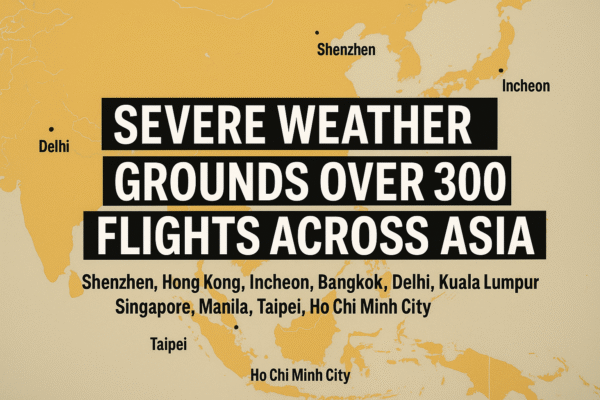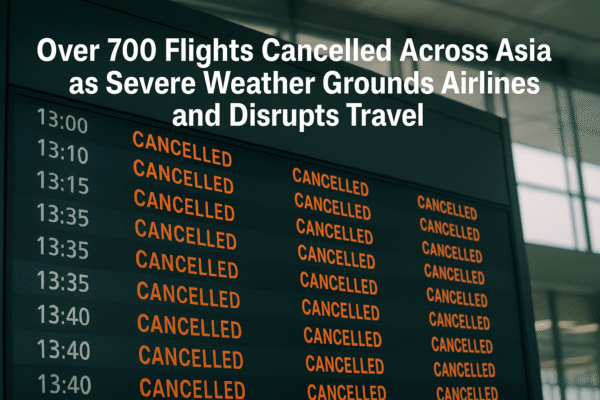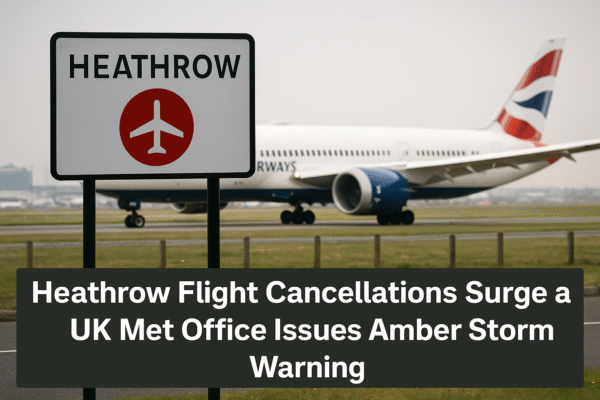LONDON, UK – July 21, 2025 – Travelers heading to and from Heathrow Airport faced significant disruption over the weekend as the UK’s Met Office issued an amber weather warning for severe thunderstorms across London and southeast England. Torrential rain, lightning, and flash flooding have led to widespread flight cancellations, rail delays, and hazardous road conditions, with British Airways among the hardest-hit carriers.
The amber warning, one of the most serious issued by the Met Office, remains in effect through Monday morning, affecting major transport arteries and international travel connections. With more than 100 flights cancelled and numerous others delayed, Heathrow—the UK’s busiest airport—has been thrown into disarray at the height of the summer travel season.
Met Office Amber Alert Causes National Disruption
According to the UK Met Office, the amber alert was activated from 4 a.m. to 11 a.m. BST on July 21 due to a powerful storm system sweeping through southern England. London, Kent, Hampshire, Cambridgeshire, and other parts of southeast England experienced between 30mm to 100mm of rain within hours, accompanied by gusty winds and frequent lightning strikes.
The Met Office warned of flash flooding, blocked roads, overwhelmed drainage systems, and potential power outages, advising residents and travelers to exercise extreme caution. This mid-July weather phenomenon comes as an increasing number of climate-induced events disrupt Europe’s aviation sector.
Heathrow: British Airways Cancels Multiple Flights
British Airways, the main tenant at Heathrow, was forced to cancel dozens of flights, particularly short-haul routes to European destinations. Many long-haul operations were also delayed, including flights to New York, Dubai, and Johannesburg. Passengers were urged to check their flight status directly with the airline or Heathrow Airport’s live departures board before heading to the terminal.
In a statement, British Airways confirmed:
“Due to severe weather warnings issued by the UK Met Office, we have made adjustments to our schedule for safety reasons. We apologize to our customers for the disruption and are offering rebooking or refund options.”
Other international carriers operating out of Heathrow—including Emirates, Lufthansa, Qatar Airways, and United Airlines—also experienced delays or rerouted flights due to the deteriorating weather and air traffic control restrictions.
Rail and Road Travel Impacted Across Southeast England
The transport disruption extended beyond air travel. National Rail reported widespread delays and service suspensions, particularly affecting Southeastern, Thameslink, and Southern lines. Flooded tracks and power disruptions brought some routes to a halt, with passengers in regions such as Kent, Surrey, and Greater London stranded or forced to use alternative connections.
Meanwhile, major roads around Heathrow and central London—including the M25, A40, and A4—were impacted by flash flooding and standing water, resulting in traffic jams and increased accident risks. The UK’s Highways Agency advised motorists to avoid unnecessary travel and check conditions before setting out.
Travel Tips and Emergency Recommendations
As weather-related cancellations continue, authorities have issued the following travel guidance for those affected by the storm system:
- Check your flight status: Visit the Heathrow Airport website or airline apps for the latest departure and arrival information.
- Contact your airline: British Airways and other carriers are waiving change fees and offering refunds or vouchers.
- Allow extra time: Congested roads and slower airport processing due to weather disruptions may cause additional delays.
- Monitor public transport updates: Use the National Rail Enquiries app and Transport for London’s website to track rail and bus changes.
- Stay safe: Follow Met Office alerts and avoid traveling in high-risk weather if your plans are flexible.
According to Heathrow Airport officials, priority is being given to rescheduling stranded passengers and minimizing overnight stays. Extra staff have been deployed in terminals to support affected travelers, and hotel booking assistance is being provided for those whose flights have been canceled at the last minute.
A Summer of Travel Challenges in the UK
The recent bout of storm-induced cancellations at Heathrow is the latest in a series of weather-related incidents impacting UK aviation. Just weeks earlier, airports across the country—including Manchester and Gatwick—faced delays from unseasonal rain and heatwaves.
July marks one of the busiest months for British air travel, with millions of holidaymakers flying to Europe, North America, and beyond. Heathrow handles over 200,000 passengers daily during peak periods, making any operational disruption particularly impactful.
The UK Civil Aviation Authority has urged airlines to be proactive in communicating with passengers and ensuring compensation policies are followed in accordance with EU261 and UK aviation consumer laws.
Looking Ahead
With additional thunderstorms forecast for the week, travelers are advised to continue monitoring weather reports and plan accordingly. The UK Met Office suggests that unsettled conditions will persist over the coming days, although the severity of the current storm is expected to ease by midweek.
In the meantime, holidaymakers, business travelers, and transport authorities across the UK are left grappling with the challenge of navigating an increasingly unpredictable climate—one that’s becoming a serious disruptor to international travel.
For more travel news like this, keep reading Global Travel Wire






















